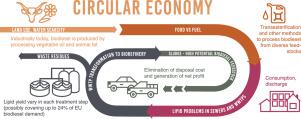Resources, Conservation and Recycling ( IF 11.2 ) Pub Date : 2020-07-08 , DOI: 10.1016/j.resconrec.2020.105044 Zuzana Frkova , Silvia Venditti , Patrick Herr , Joachim Hansen

|
Production of biodiesel is one of the most important European targets within renewables for the future. To consider biodiesel a feasible alternative to fossil fuel, unconventional resources need to be exploited. This review aims to provide up-to-date knowledge on the existing reuse of lipids from urban wastewater to produce biodiesel. Lipids are readily removed by mixed microbial populations during wastewater treatments in sewage plants. Assessment results on potential annual European market supply indicate 3 – 414 104 tons (min for activated and max for grease trap sludge) of potentially extractable biodiesel from wastewater and an expected biodiesel demand of 14.8 106 tons. Considering the prospect of transforming sewage plants into biorefineries, we may cover on average 1.5, 6.2, 6.7 and 24.4% of activated, primary, scum and grease trap sludge respectively, of the European biodiesel market from wastewater-derived lipids. In addition, by implementing an optimized biotechnology selector, the overall biodiesel yield could be higher due to increased lipid incorporation into microbial biomass. This is not an insignificant amount and, if efficiently implemented, could represent an exploitable resource for biofuel production, an important and desired step towards a circular economy. The technology readiness level is still very low. There are several challenges and possible drawbacks, e.g., biogas yield loss, substrate depletion, or formation of floating sludge. Finally, no definitive legislative barriers towards wastewater-derived lipids have been identified; however, quality criteria as well as waste status have to be defined.
中文翻译:

从城市废水中产生的脂质生产生物柴油的评估
生物柴油的生产是未来可再生能源中欧洲最重要的目标之一。为了将生物柴油视为化石燃料的可行替代品,需要开发非常规资源。这篇综述旨在提供有关城市废水中脂质的现有再利用以生产生物柴油的最新知识。在污水处理厂的废水处理过程中,脂质容易被混合微生物群去除。对欧洲潜在年度市场供应量的评估结果表明,废水中可提取的生物柴油为3 – 414 10 4吨(活化的最小值,油脂捕集器污泥的最大值),预期的生物柴油需求为14.8 10 6吨。考虑到将污水处理厂转变为生物精炼厂的前景,我们可以从废水中产生的脂质分别平均覆盖欧洲生物柴油市场中活化,初级,浮渣和油脂收集器污泥的1.5%,6.2%,6.7%和24.4%。另外,通过实施优化的生物技术选择器,由于脂质掺入微生物生物量的增加,总的生物柴油产量可能更高。这不是微不足道的数额,而且如果得到有效实施,就可以代表可用于生物燃料生产的资源,这是朝着循环经济迈出的重要而理想的一步。技术准备水平仍然很低。存在若干挑战和可能的缺点,例如沼气产量损失,底物耗竭或形成浮泥。最后,尚未确定对废水衍生脂质的明确立法障碍;但是,必须定义质量标准以及废物状态。









































 京公网安备 11010802027423号
京公网安备 11010802027423号